warning light DODGE NITRO 2008 1.G Service Manual
[x] Cancel search | Manufacturer: DODGE, Model Year: 2008, Model line: NITRO, Model: DODGE NITRO 2008 1.GPages: 434, PDF Size: 6.2 MB
Page 305 of 434
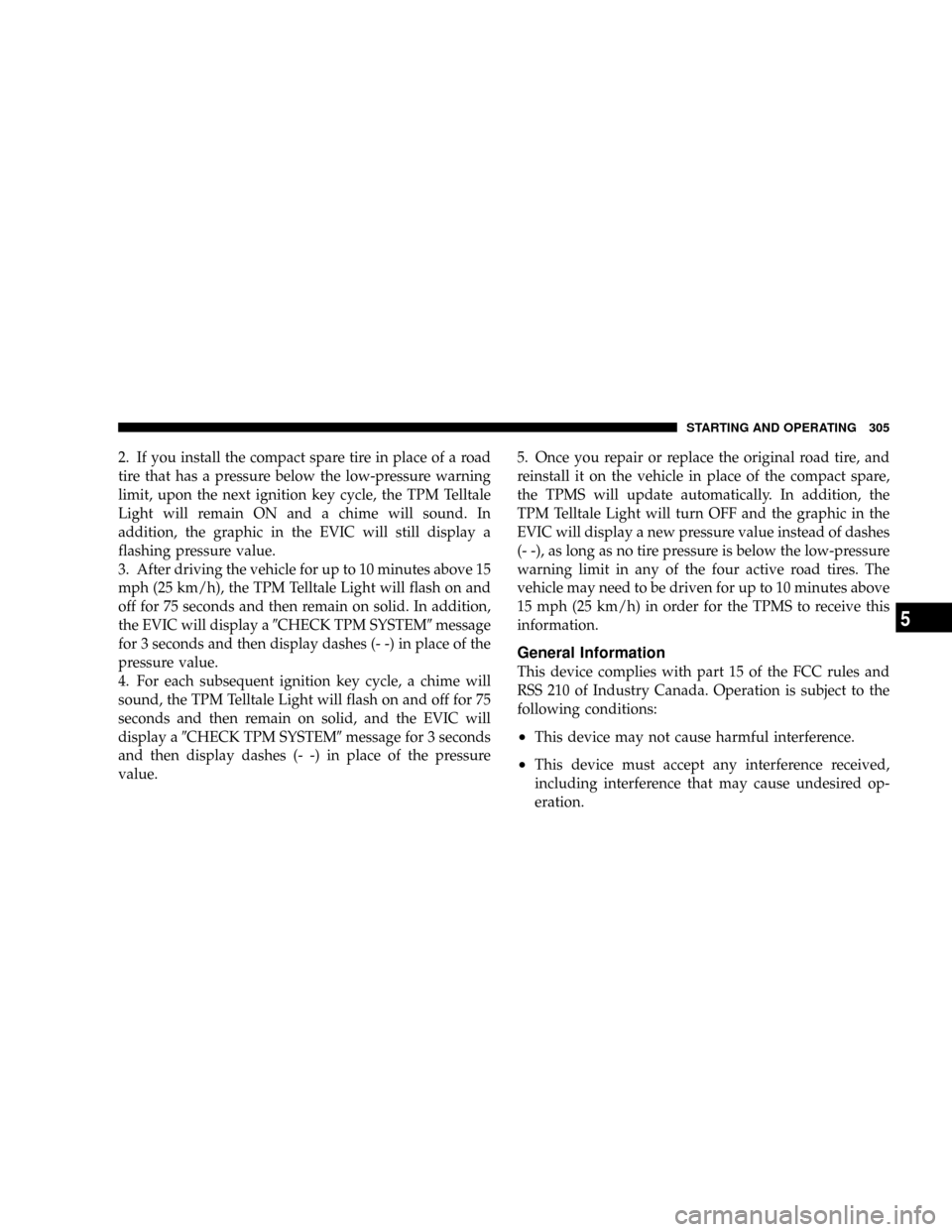
2. If you install the compact spare tire in place of a road
tire that has a pressure below the low-pressure warning
limit, upon the next ignition key cycle, the TPM Telltale
Light will remain ON and a chime will sound. In
addition, the graphic in the EVIC will still display a
flashing pressure value.
3. After driving the vehicle for up to 10 minutes above 15
mph (25 km/h), the TPM Telltale Light will flash on and
off for 75 seconds and then remain on solid. In addition,
the EVIC will display a9CHECK TPM SYSTEM9message
for 3 seconds and then display dashes (- -) in place of the
pressure value.
4. For each subsequent ignition key cycle, a chime will
sound, the TPM Telltale Light will flash on and off for 75
seconds and then remain on solid, and the EVIC will
display a9CHECK TPM SYSTEM9message for 3 seconds
and then display dashes (- -) in place of the pressure
value.5. Once you repair or replace the original road tire, and
reinstall it on the vehicle in place of the compact spare,
the TPMS will update automatically. In addition, the
TPM Telltale Light will turn OFF and the graphic in the
EVIC will display a new pressure value instead of dashes
(- -), as long as no tire pressure is below the low-pressure
warning limit in any of the four active road tires. The
vehicle may need to be driven for up to 10 minutes above
15 mph (25 km/h) in order for the TPMS to receive this
information.
General Information
This device complies with part 15 of the FCC rules and
RSS 210 of Industry Canada. Operation is subject to the
following conditions:
²This device may not cause harmful interference.
²This device must accept any interference received,
including interference that may cause undesired op-
eration.
STARTING AND OPERATING 305
5
Page 309 of 434

²The use of leaded gas is prohibited by Federal law.
Using leaded gasoline can impair engine performance,
damage the emission control system.
²An out-of-tune engine, or certain fuel or ignition
malfunctions, can cause the catalytic converter to
overheat. If you notice a pungent burning odor or
some light smoke, your engine may be out of tune or
malfunctioning and may require immediate service.
Contact your dealer for service assistance.
²The use of fuel additives which are now being sold as
octane enhancers is not recommended. Most of these
products contain high concentrations of methanol.
Fuel system damage or vehicle performance problems
resulting from the use of such fuels or additives is not
the responsibility of the manufacturer.
NOTE:Intentional tampering with emissions control
systems can result in civil penalties being assessed
against you.
Carbon Monoxide Warnings
WARNING!
Carbon monoxide (CO) in exhaust gases is deadly.
Follow the precautions below to prevent carbon
monoxide poisoning:
²Do not inhale exhaust gases. They contain carbon
monoxide, a colorless and odorless gas which can kill.
Never run the engine in a closed area, such as a
garage, and never sit in a parked vehicle with the
engine running for an extended period. If the vehicle is
stopped in an open area with the engine running for
more than a short period, adjust the ventilation system
to force fresh, outside air into the vehicle.
STARTING AND OPERATING 309
5
Page 311 of 434
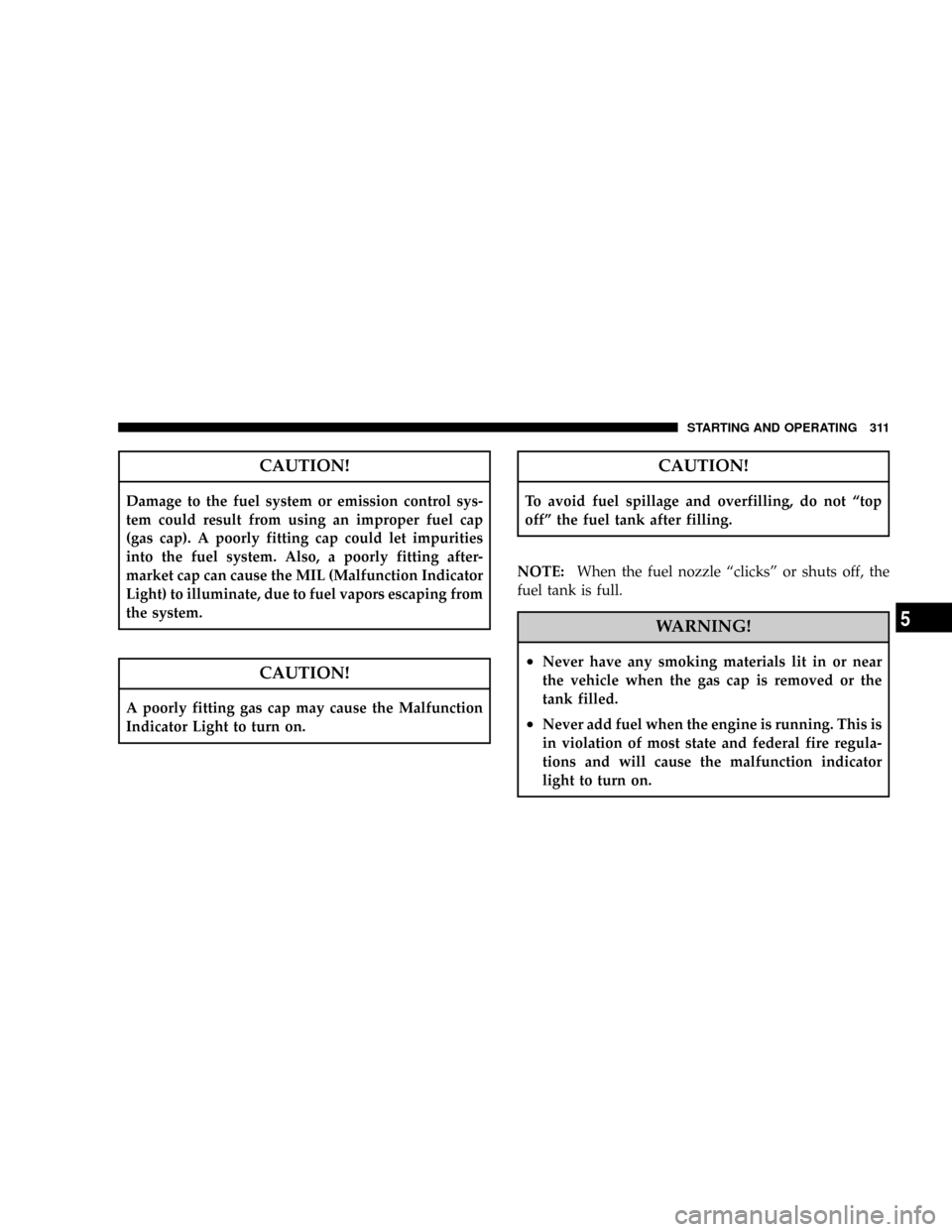
CAUTION!
Damage to the fuel system or emission control sys-
tem could result from using an improper fuel cap
(gas cap). A poorly fitting cap could let impurities
into the fuel system. Also, a poorly fitting after-
market cap can cause the MIL (Malfunction Indicator
Light) to illuminate, due to fuel vapors escaping from
the system.
CAUTION!
A poorly fitting gas cap may cause the Malfunction
Indicator Light to turn on.
CAUTION!
To avoid fuel spillage and overfilling, do not ªtop
offº the fuel tank after filling.
NOTE:When the fuel nozzle ªclicksº or shuts off, the
fuel tank is full.
WARNING!
²Never have any smoking materials lit in or near
the vehicle when the gas cap is removed or the
tank filled.
²Never add fuel when the engine is running. This is
in violation of most state and federal fire regula-
tions and will cause the malfunction indicator
light to turn on.
STARTING AND OPERATING 311
5
Page 312 of 434
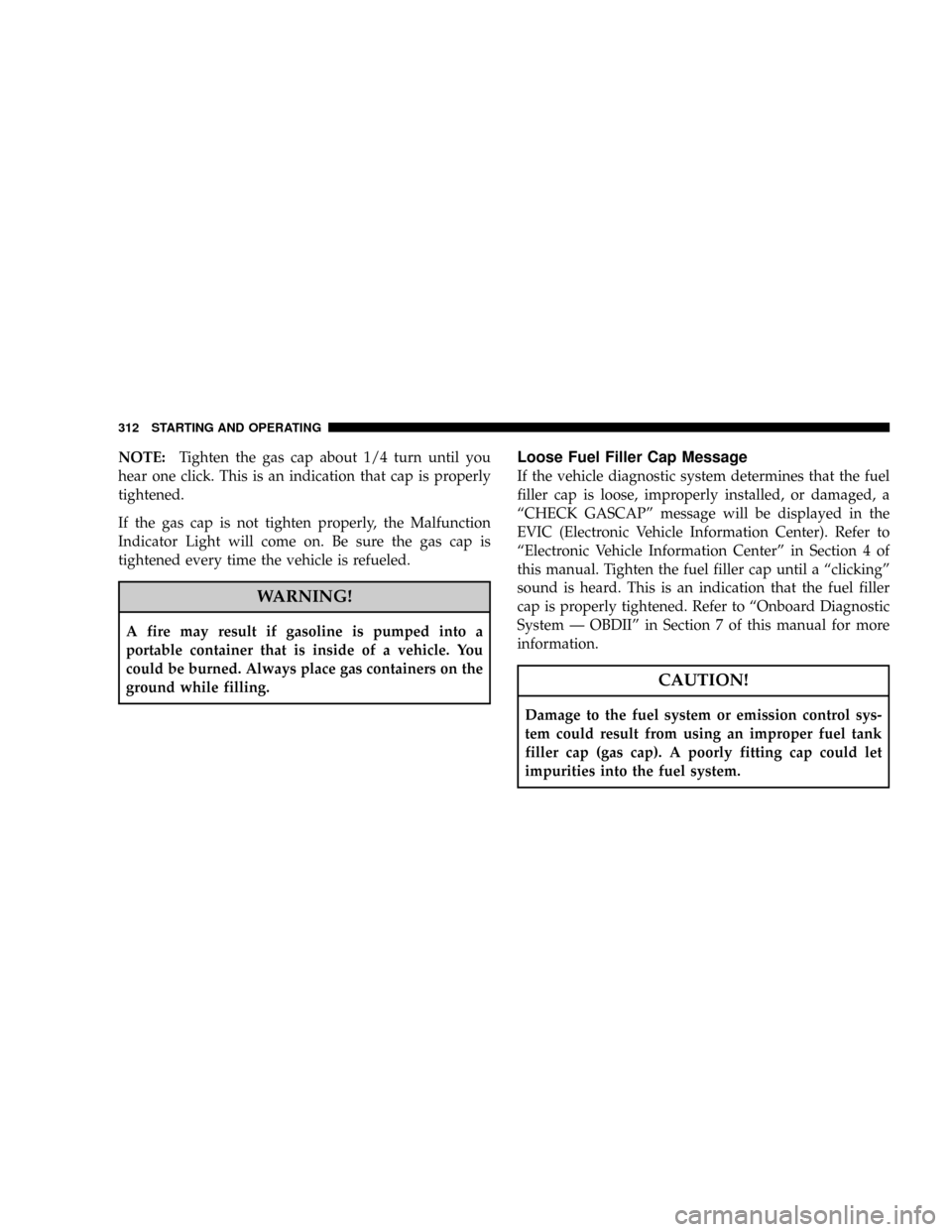
NOTE:Tighten the gas cap about 1/4 turn until you
hear one click. This is an indication that cap is properly
tightened.
If the gas cap is not tighten properly, the Malfunction
Indicator Light will come on. Be sure the gas cap is
tightened every time the vehicle is refueled.
WARNING!
A fire may result if gasoline is pumped into a
portable container that is inside of a vehicle. You
could be burned. Always place gas containers on the
ground while filling.
Loose Fuel Filler Cap Message
If the vehicle diagnostic system determines that the fuel
filler cap is loose, improperly installed, or damaged, a
ªCHECK GASCAPº message will be displayed in the
EVIC (Electronic Vehicle Information Center). Refer to
ªElectronic Vehicle Information Centerº in Section 4 of
this manual. Tighten the fuel filler cap until a ªclickingº
sound is heard. This is an indication that the fuel filler
cap is properly tightened. Refer to ªOnboard Diagnostic
System Ð OBDIIº in Section 7 of this manual for more
information.
CAUTION!
Damage to the fuel system or emission control sys-
tem could result from using an improper fuel tank
filler cap (gas cap). A poorly fitting cap could let
impurities into the fuel system.
312 STARTING AND OPERATING
Page 327 of 434

WARNING!
Do not connect trailer brakes to your vehicle's hy-
draulic brake lines. It can overload your brake sys-
tem and cause it to fail. You might not have brakes
when you need them and could have an accident.
Towing any trailer will increase your stopping dis-
tance. When towing you should allow for additional
space between your vehicle and the vehicle in front
of you. Failure to do so could result in an accident.
Towing Requirements Ð Trailer Lights & Wiring
Whenever you pull a trailer, regardless of the trailer size,
stop lights and turn signals on the trailer are required for
motoring safety.
The Trailer Tow Package may includea4and7pin
wiring harness. Use a factory approved trailer harness
and connector.
NOTE:Do not cut or splice wiring into the vehicles
wiring harness.
STARTING AND OPERATING 327
5
Page 340 of 434

5. Raise the vehicle by turning the jack screw to the right.
Raise the vehicle only until the tire just clears the surface
and enough clearance is obtained to install the spare tire.
Minimum tire lift provides maximum stability.
WARNING!
Raising the vehicle higher than necessary can make
the vehicle less stable and cause an accident. It could
slip off the jack and hurt someone near it. Raise the
vehicle only enough to remove the tire.
6. Remove the lug nuts and wheel.
7. Position the spare wheel/tire on the vehicle and install
lug nuts with cone-shaped end toward wheel. Lightly
tighten the nuts. To avoid the risk of forcing the vehicle
off the jack, do not tighten the nuts fully until the vehicle
has been lowered.
8. Lower the vehicle by turning the jack screw to the left,
and remove the jack and wheel blocks.
Rear Jacking Location
340 WHAT TO DO IN EMERGENCIES
Page 373 of 434
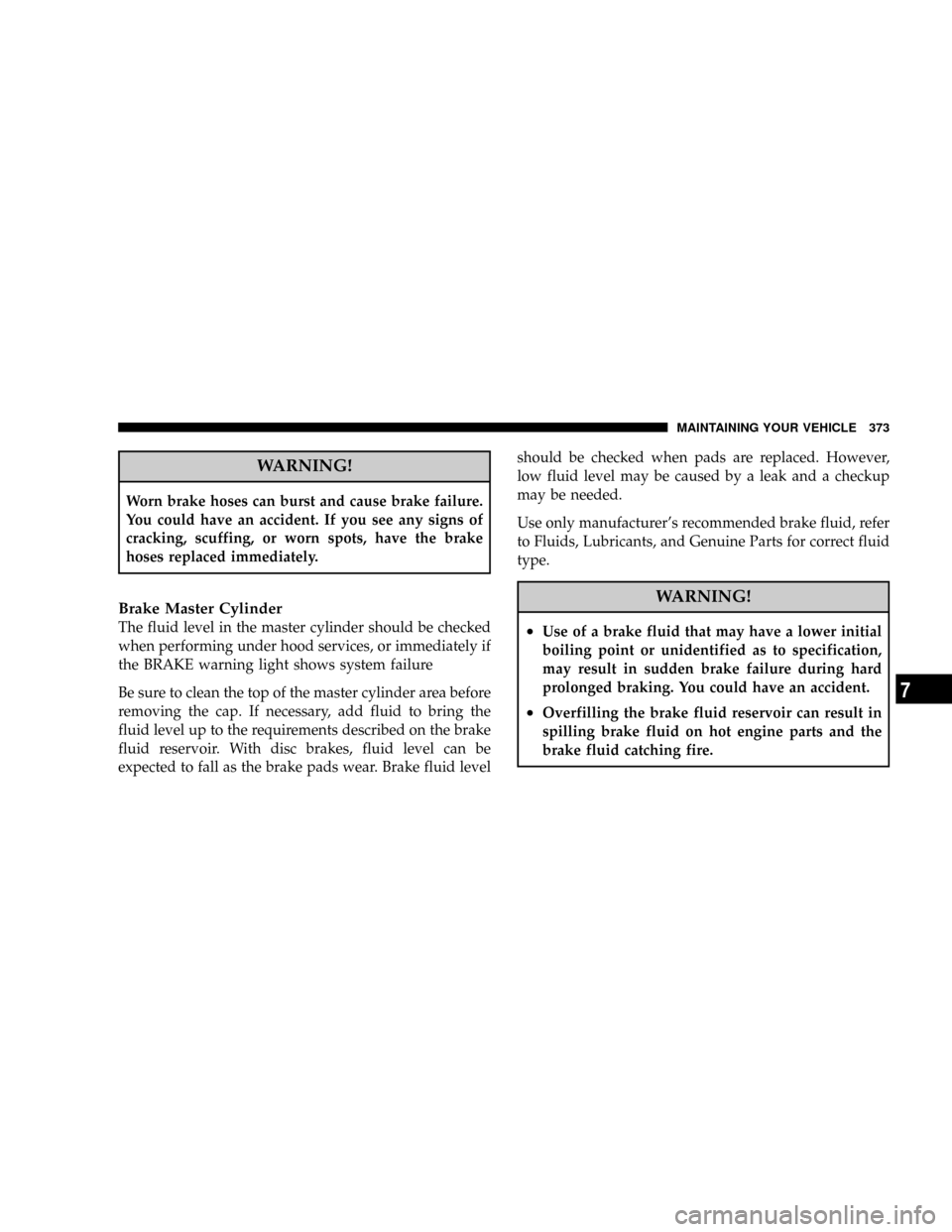
WARNING!
Worn brake hoses can burst and cause brake failure.
You could have an accident. If you see any signs of
cracking, scuffing, or worn spots, have the brake
hoses replaced immediately.
Brake Master Cylinder
The fluid level in the master cylinder should be checked
when performing under hood services, or immediately if
the BRAKE warning light shows system failure
Be sure to clean the top of the master cylinder area before
removing the cap. If necessary, add fluid to bring the
fluid level up to the requirements described on the brake
fluid reservoir. With disc brakes, fluid level can be
expected to fall as the brake pads wear. Brake fluid levelshould be checked when pads are replaced. However,
low fluid level may be caused by a leak and a checkup
may be needed.
Use only manufacturer's recommended brake fluid, refer
to Fluids, Lubricants, and Genuine Parts for correct fluid
type.
WARNING!
²Use of a brake fluid that may have a lower initial
boiling point or unidentified as to specification,
may result in sudden brake failure during hard
prolonged braking. You could have an accident.
²Overfilling the brake fluid reservoir can result in
spilling brake fluid on hot engine parts and the
brake fluid catching fire.
MAINTAINING YOUR VEHICLE 373
7
Page 416 of 434

About Your Brakes....................... 272
ABS (Anti-Lock Brake System)............173,274
Adding Fuel........................... 310
Adding Washer Fluid..................... 159
Air Cleaner, Engine (Engine Air Cleaner Filter) . . . 361
Air Conditioner Maintenance............... 362
Air Conditioning.....................235,238
Air Conditioning Controls................. 238
Air Conditioning, Operating Tips............ 239
Air Conditioning Refrigerant............... 363
Air Conditioning System.................. 238
Air Filter.............................. 361
Air Pressure, Tires....................... 288
Airbag.............................49,174
Airbag Deployment....................... 61
Airbag Light..........................63,77
Airbag Maintenance....................... 63
Alarm, Panic............................ 23
Alarm (Security Alarm).................18,170Alarm System (Security Alarm)............... 18
Alignment and Balance................... 293
Alterations/Modifications, Vehicle............. 8
Antenna, Satellite Radio................... 228
Antifreeze (Engine Coolant)................ 394
Anti-Lock Brake System (ABS)............131,274
Anti-Lock Warning Light.................. 173
Anti-Theft System.....................18,170
Appearance Care........................ 377
Auto Down Power Windows................ 34
Automatic Dimming Mirror................. 84
Automatic Transaxle...................... 252
Automatic Transmission.............255,260,374
Fluid and Filter Changes................. 374
Fluid Level Check...................374,375
Fluid Type........................374,396
Gear Ranges.......................... 255
Special Additives...................... 375
Torque Converter...................259,264
416 INDEX
Page 417 of 434
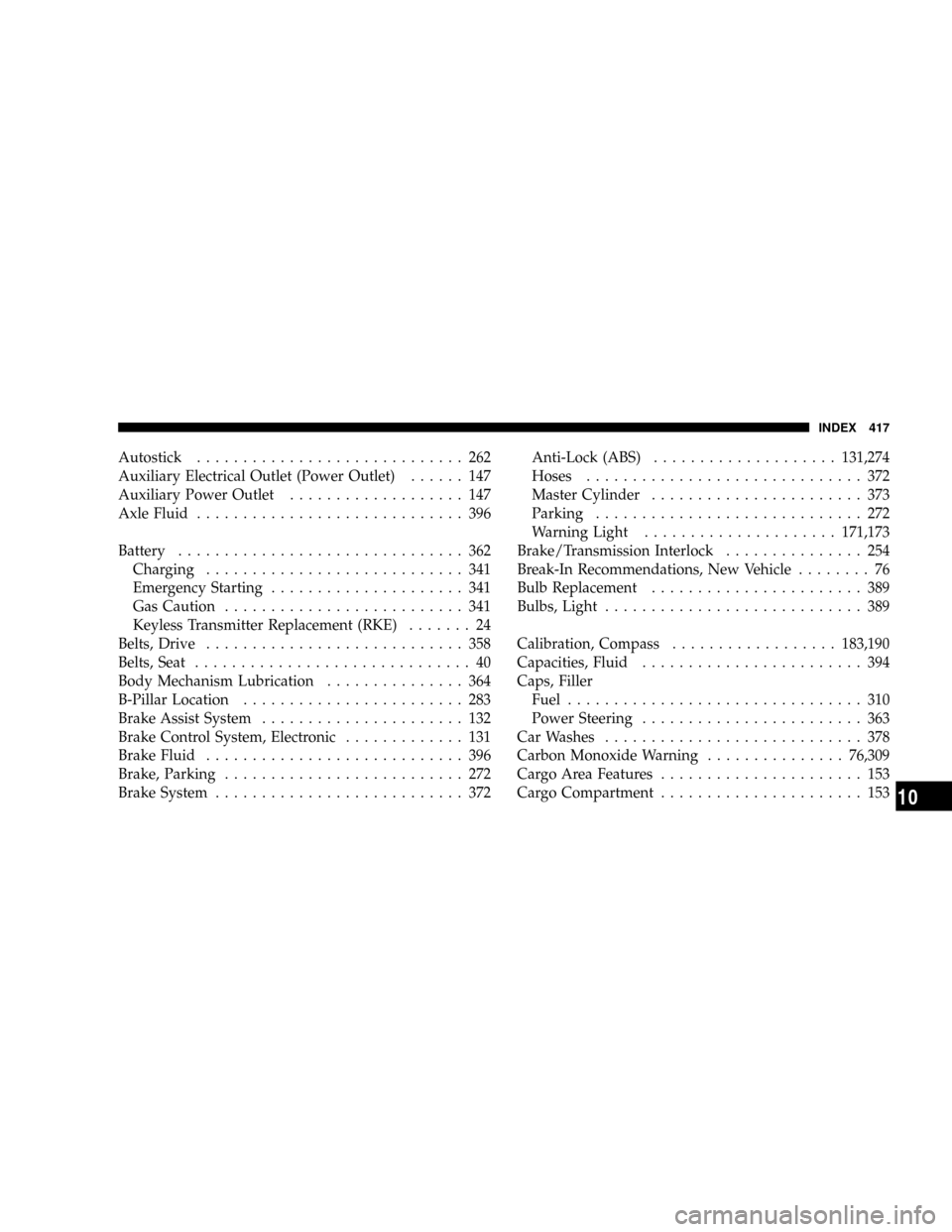
Autostick............................. 262
Auxiliary Electrical Outlet (Power Outlet)...... 147
Auxiliary Power Outlet................... 147
Axle Fluid............................. 396
Battery............................... 362
Charging............................ 341
Emergency Starting..................... 341
Gas Caution.......................... 341
Keyless Transmitter Replacement (RKE)....... 24
Belts, Drive............................ 358
Belts, Seat.............................. 40
Body Mechanism Lubrication............... 364
B-Pillar Location........................ 283
Brake Assist System...................... 132
Brake Control System, Electronic............. 131
Brake Fluid............................ 396
Brake, Parking.......................... 272
Brake System........................... 372Anti-Lock (ABS)....................131,274
Hoses.............................. 372
Master Cylinder....................... 373
Parking............................. 272
Warning Light.....................171,173
Brake/Transmission Interlock............... 254
Break-In Recommendations, New Vehicle........ 76
Bulb Replacement....................... 389
Bulbs, Light............................ 389
Calibration, Compass..................183,190
Capacities, Fluid........................ 394
Caps, Filler
Fuel................................ 310
Power Steering........................ 363
Car Washes............................ 378
Carbon Monoxide Warning...............76,309
Cargo Area Features...................... 153
Cargo Compartment...................... 153
INDEX 417
10
Page 421 of 434
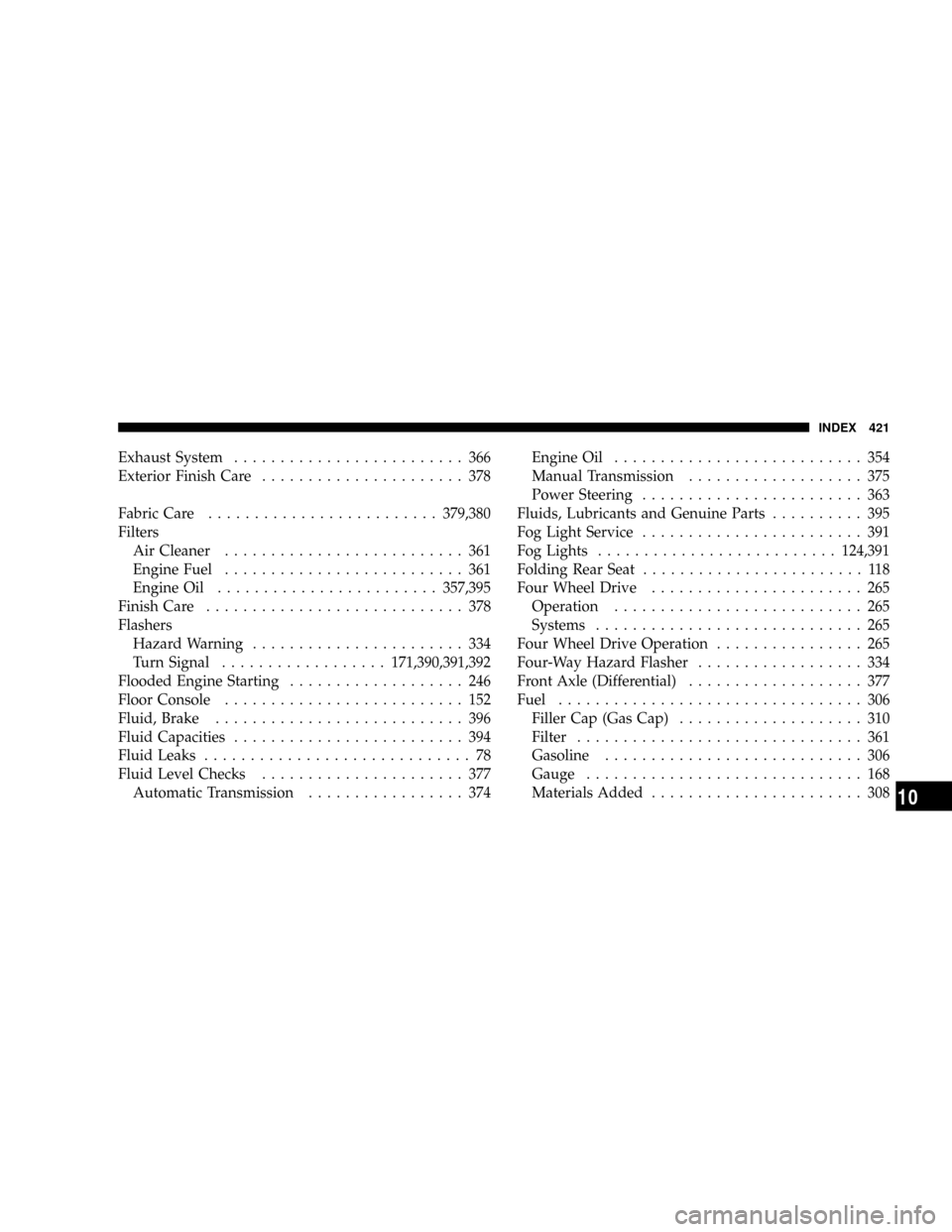
Exhaust System......................... 366
Exterior Finish Care...................... 378
Fabric Care.........................379,380
Filters
Air Cleaner.......................... 361
Engine Fuel.......................... 361
Engine Oil........................357,395
Finish Care............................ 378
Flashers
Hazard Warning....................... 334
Turn Signal..................171,390,391,392
Flooded Engine Starting................... 246
Floor Console.......................... 152
Fluid, Brake........................... 396
Fluid Capacities......................... 394
Fluid Leaks............................. 78
Fluid Level Checks...................... 377
Automatic Transmission................. 374Engine Oil........................... 354
Manual Transmission................... 375
Power Steering........................ 363
Fluids, Lubricants and Genuine Parts.......... 395
Fog Light Service........................ 391
Fog Lights..........................124,391
Folding Rear Seat........................ 118
Four Wheel Drive....................... 265
Operation........................... 265
Systems............................. 265
Four Wheel Drive Operation................ 265
Four-Way Hazard Flasher.................. 334
Front Axle (Differential)................... 377
Fuel................................. 306
Filler Cap (Gas Cap).................... 310
Filter............................... 361
Gasoline............................ 306
Gauge.............................. 168
Materials Added....................... 308
INDEX 421
10